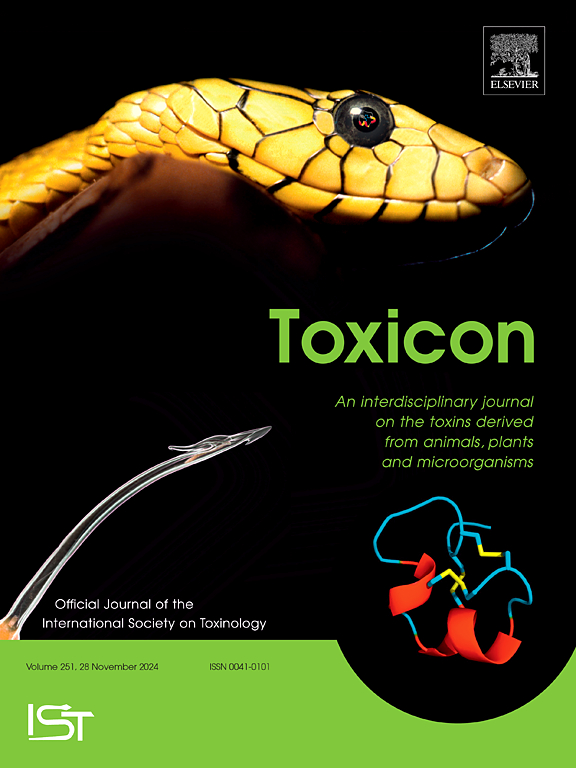Lutein and Zeaxanthin abated neurobehavioral, neurochemical and oxido-inflammatory derangement in rats intoxicated with Aflatoxin B1
IF 2.6
4区 医学
Q2 PHARMACOLOGY & PHARMACY
引用次数: 0
Abstract
Aflatoxin B1 (AFB1), a mycotoxin commonly present in feed, has several toxic effects. AFB1 seems to have a neurotoxic effect that leads to neurobehavioral impairment. On the other hand, Lutein and Zeaxanthin (LUT/ZEA) have antioxidant and anti-inflammatory effects. Here, we aimed to compare the effects of AFB1 and the co-treatment with LUT/ZEA on neurobehavioural and biochemical changes viz-a-viz oxido-inflammatory response in male rats' hippocampal and pre-frontal cortexes. Experimental rats of the Wistar strain (n = 40) were randomly grouped into treatment cohorts: Control (corn oil 2 mL/kg), AFB1 (75 μg/kg), LUT/ZEA only (100 mg/kg), AFB1 + LUT/ZEA (75 μg/kg + 100 mg/kg), and AFB1 + LUT/ZEA (75 μg/kg + 200 mg/kg). All groups were administered their respective treatment orally for 28 days, while behavioural tests were conducted using open field tests (OFT), Y-maze, novel object tests (NORT), and forced swim tests (FST) 1 h after treatment on day 26–28. The animals were euthanized on day 29. In the hippocampal and pre-frontal cortex, antioxidant indicators (SOD, CAT, GSH, GST, GPx, TSH), inflammatory mediators (XO, NO, MPO), and acetylcholinesterase activity were measured. Our finding presents the anti-oxidant effect of lutein/Zeaxanthin in the brains of AFB1-intoxicated rats, indicating better cognitive and spatial memory capacity in Y-maze and NORT, an improvement in locomotive and explorative behaviour in OFT and reduction in anxio-depressive-like behaviour in LUT/ZEA co-treated rats. Acetylcholinesterase activity was enhanced in LUT/ZEA co-treated rats. LUT/ZEA co-treatment dampened oxido-inflammatory mediators by decreasing XO, NO, and MPO levels and increasing antioxidant activities (SOD, CAT, GSH, GST, GPx, TSH) in the prefrontal and hippocampal cortices. We surmise that mechanistically, co-treatment with LUT/ZEA effectively lessened AFB1 neurotoxicity through anti-inflammatory and antioxidant pathways and essentially improved the experimental rats' neurobehavioural outcomes.

叶黄素和玉米黄质可减轻黄曲霉毒素 B1 中毒大鼠的神经行为、神经化学和氧化炎症失调
黄曲霉毒素B1 (AFB1)是饲料中常见的一种霉菌毒素,具有几种毒性作用。AFB1似乎具有导致神经行为障碍的神经毒性作用。另一方面,叶黄素和玉米黄质(LUT/ZEA)具有抗氧化和抗炎作用。在这里,我们旨在比较AFB1以及与LUT/ZEA联合治疗对雄性大鼠海马和前额叶皮层氧化炎症反应的神经行为和生化变化的影响。Wistar菌株实验大鼠(n = 40)随机分为对照(玉米油2 mL/kg)、AFB1 (75 μg/kg)、LUT/ZEA单独(100 mg/kg)、AFB1 + LUT/ZEA (75 μg/kg + 100 mg/kg)和AFB1 + LUT/ZEA (75 μg/kg + 200 mg/kg)处理组。各组大鼠分别口服治疗28 d,并于治疗后1 h(第26-28天)进行行为学测试,包括开放场试验(OFT)、y型迷宫、新物体试验(NORT)和强迫游泳试验(FST)。这些动物在第29天被安乐死。在海马和前额叶皮层,测定抗氧化指标(SOD、CAT、GSH、GST、GPx、TSH)、炎症介质(XO、NO、MPO)和乙酰胆碱酯酶活性。我们的研究结果表明叶黄素/玉米黄质在afb1中毒大鼠的大脑中具有抗氧化作用,表明在y迷宫和NORT中具有更好的认知和空间记忆能力,在OFT中改善了运动和探索行为,并减少了LUT/ZEA共处理大鼠的焦虑-抑郁样行为。LUT/ZEA共处理大鼠乙酰胆碱酯酶活性增强。LUT/ZEA共处理通过降低XO、NO和MPO水平和增加前额叶和海马皮层的抗氧化活性(SOD、CAT、GSH、GST、GPx、TSH)来抑制氧化炎症介质。我们推测,从机制上说,与LUT/ZEA联合治疗通过抗炎和抗氧化途径有效地减轻了AFB1的神经毒性,并从根本上改善了实验大鼠的神经行为结果。
本文章由计算机程序翻译,如有差异,请以英文原文为准。
求助全文
约1分钟内获得全文
求助全文
来源期刊

Toxicon
医学-毒理学
CiteScore
4.80
自引率
10.70%
发文量
358
审稿时长
68 days
期刊介绍:
Toxicon has an open access mirror Toxicon: X, sharing the same aims and scope, editorial team, submission system and rigorous peer review. An introductory offer Toxicon: X - full waiver of the Open Access fee.
Toxicon''s "aims and scope" are to publish:
-articles containing the results of original research on problems related to toxins derived from animals, plants and microorganisms
-papers on novel findings related to the chemical, pharmacological, toxicological, and immunological properties of natural toxins
-molecular biological studies of toxins and other genes from poisonous and venomous organisms that advance understanding of the role or function of toxins
-clinical observations on poisoning and envenoming where a new therapeutic principle has been proposed or a decidedly superior clinical result has been obtained.
-material on the use of toxins as tools in studying biological processes and material on subjects related to venom and antivenom problems.
-articles on the translational application of toxins, for example as drugs and insecticides
-epidemiological studies on envenoming or poisoning, so long as they highlight a previously unrecognised medical problem or provide insight into the prevention or medical treatment of envenoming or poisoning. Retrospective surveys of hospital records, especially those lacking species identification, will not be considered for publication. Properly designed prospective community-based surveys are strongly encouraged.
-articles describing well-known activities of venoms, such as antibacterial, anticancer, and analgesic activities of arachnid venoms, without any attempt to define the mechanism of action or purify the active component, will not be considered for publication in Toxicon.
-review articles on problems related to toxinology.
To encourage the exchange of ideas, sections of the journal may be devoted to Short Communications, Letters to the Editor and activities of the affiliated societies.
 求助内容:
求助内容: 应助结果提醒方式:
应助结果提醒方式:


